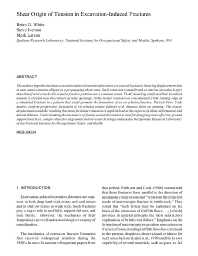Mining Publication: Shear Origin of Tension in Excavation-Induced Fractures
Original creation date: June 2003
The authors hypothesize that excavation-induced extension fractures are caused by elastic shearing displacement that in turn causes tension oblique to a propagating shear zone. Such extension is manifested as tension on scales larger than that of microcracks. En echelon fracture patterns are a common result. FLAC modeling confirmed that localized tension is created near the corners of mine openings. In the model, tension was concentrated at the leading edge of a simulated fracture in a pattern that could promote the formation of an en echelon fracture. Particle Flow Code models confirm progressive formation of en echelon tensile failures with distance from an opening. The elastic displacements and the resulting fractures facilitate reduction in applied load at the expense of shear deformation and lateral dilation. Understanding the mechanics of fracture and deformation is vital for designing more effective ground support practices, a major objective of ground control research being conducted at the Spokane Research Laboratory of the National Institute for Occupational Safety and Health.
Authors: BG White, SR Iverson, MK Larson
Conference Paper - June 2003
NIOSHTIC2 Number: 20024130
Culligan PJ, Einstein HH, Whittle AJ, eds. Soil and Rock America 2003. 12th Panamerican Conference on Soil Mechanics and Geotechnical Engineering and the 39th U.S. Rock Mechanics Symposium, Vol. 1. Cambridge, MA: Massachusetts Institute of Technology, 2003 Jun; 1:909-916
See Also
- 60 Years of Rockbursting in the Coeur D'Alene District of Northern Idaho, USA: Lessons Learned and Remaining Issues
- Analysis of Mine Seismicity and Geotechnical Modeling for Improved Safety in Underground Coal Mines
- Comparison of Ground Conditions and Ground Control Practices in the United States and Australia
- Determination of In Situ Deformation Modulus for Cemented Rockfill
- Dynamic Failure in Deep Coal: Recent Trends and a Path Forward
- Evaluation of the Relative Importance of Coalbed Reservoir Parameters for Prediction of Methane Inflow Rates During Mining of Longwall Development Entries
- MCP - Methane Control and Prediction - 2.0
- Reservoir Engineering Considerations for Coal Seam Degasification and Methane Control in Underground Mines
- Shear Strength Evaluation of Clay-Rock Mixtures
- Variation of Horizontal Stresses and Strains in Mines in Bedded Deposits in the Eastern and Midwestern United States
- Page last reviewed: 9/21/2012
- Page last updated: 9/21/2012
- Content source: National Institute for Occupational Safety and Health, Mining Program


 ShareCompartir
ShareCompartir
